
Lizard is the common name used for all squamate reptiles other than snakes, encompassing over 7,000 species, ranging across all continents except Antarctica, as well as most oceanic island chains. The grouping is paraphyletic as some lizards are more closely related to snakes than they are to other lizards. Lizards range in size from chameleons and geckos a few centimeters long to the 3-meter-long Komodo dragon.

Basiliscus is a genus of large corytophanid lizards, commonly known as basilisks, which are endemic to southern Mexico, Central America, and northern South America. The genus contains four species, which are commonly known as the Jesus Christ lizard, or simply the Jesus lizard, due to their ability to run across water for significant distances before sinking due to the large surface area of their feet.
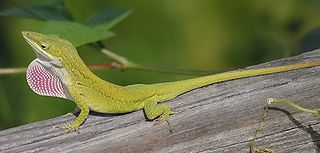
Dactyloidae are a family of lizards commonly known as anoles and native to warmer parts of the Americas, ranging from southeastern United States to Paraguay. Instead of treating it as a family, some authorities prefer to treat it as a subfamily, Dactyloinae, of the family Iguanidae. In the past they were included in the family Polychrotidae together with Polychrus, but the latter genus is not closely related to the true anoles.

The brown anole, also known commonly as the Cuban brown anole, or De la Sagra's anole, is a species of lizard in the family Dactyloidae. The species is native to Cuba and the Bahamas. It has been widely introduced elsewhere, via the importation and exportation of plants where the anole would lay eggs in the soil of the pots, and is now found in Florida and other regions of the United States including southern Georgia, Texas, Louisiana, Tennessee, Mississippi, Alabama, Hawaii, and Southern California. It has also been introduced to other Caribbean islands, Mexico, and Taiwan.
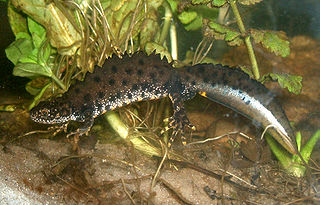
The northern crested newt, great crested newt or warty newt is a newt species native to Great Britain, northern and central continental Europe and parts of Western Siberia. It is a large newt, with females growing up to 16 cm (6.3 in) long. Its back and sides are dark brown, while the belly is yellow to orange with dark blotches. Males develop a conspicuous jagged crest on their back and tail during the breeding season.

The brown basilisk, also commonly referred to as the striped basilisk or in some areas as the common basilisk, is a species of basilisk lizard in the family Corytophanidae. The species is native to Mexico, Central America and adjacent northwestern Colombia, and has been introduced into the U.S. state of Florida as a feral species. The brown basilisk has large hind feet with narrow flaps of skin on the distal edge of each toe. The fact that they move quickly across the water gives them the appearance of "walking on water".

The common basilisk is a species of lizard in the family Corytophanidae. The species is endemic to Central America and South America, where it is found near rivers and streams in rainforests. It is also known as the Jesus Christ lizard, Jesus lizard, South American Jesus lizard, or lagarto de Jesus Cristo for its ability to run on the surface of water.

The common collared lizard, also commonly called eastern collared lizard, Oklahoma collared lizard, yellow-headed collared lizard, and collared lizard, is a North American species of lizard in the family Crotaphytidae. The common name "collared lizard" comes from the lizard's distinct coloration, which includes bands of black around the neck and shoulders that look like a collar. Males can be very colorful, with blue green bodies, yellow stripes on the tail and back, and yellow orange throats. There are five recognized subspecies.

The ornate hawk-eagle is a fairly large bird of prey from the tropical Americas. Formerly, some authorities referred to this species as the crested hawk-eagle, a name that may cause some confusion as it is more commonly used for an Asian eagle species. Like all eagles, it is in the family Accipitridae. This species has a feathered tarsus that marks it as a member of the Aquilinae or booted eagle subfamily. This species is notable for the vivid colors and bold markings of adults, which differ considerably from the far more whitish plumage of the juvenile bird. The ornate hawk-eagle ranges from central Mexico south through much of Central America and in a somewhat spotty but broad overall range into South America, including in the west apart from the Andes and broadly on the Atlantic side especially Brazil down to as far as Southeast Brazil and northern Argentina. This species is found largely in primary forests with tall trees, although can be found in many forest types.
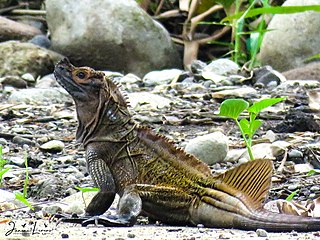
Hydrosaurus pustulatus, commonly known as the Philippine sailfin lizard or the Philippine sailfin dragon, is a large semiaquatic agamid lizard endemic to all of the major island groups of the Philippines, with the exception of the Palawan islands. Like other sailfin lizards, they are characterized by large sail-like dorsal crests on their tails. They can grow to a maximum length of around 3 to 4 ft. They are strong swimmers, and smaller juvenile lizards can run briefly on the water surface. They inhabit areas of heavy vegetation near coastlines and low-lying rivers, particularly in mangrove forests. They are also known locally as layagan or balubid in Tagalog and ibid in the Visayan languages, among other names.

Triturus is a genus of newts comprising the crested and the marbled newts, which are found from Great Britain through most of continental Europe to westernmost Siberia, Anatolia, and the Caspian Sea region. Their English names refer to their appearance: marbled newts have a green–black colour pattern, while the males of crested newts, which are dark brown with a yellow or orange underside, develop a conspicuous jagged seam on their back and tail during their breeding phase.
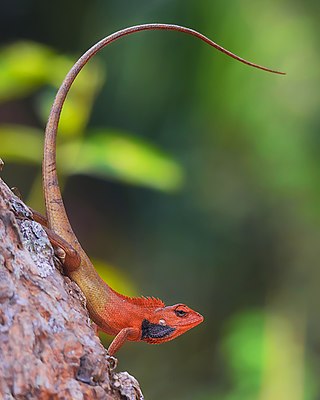
The oriental garden lizard, also called the eastern garden lizard, Indian garden lizard, common garden lizard, bloodsucker or changeable lizard, is an agamid lizard found widely distributed in Indo-Malaya. It has also been introduced in many other parts of the world.

The collared sparrowhawk is a small, slim bird of prey in the family Accipitridae found in Australia, New Guinea and nearby smaller islands. As its name implies the collared sparrowhawk is a specialist in hunting small birds. It is characterised by its slight brow ridges and slender feet. The last segment of their middle toe projects beyond the claws of the other toes.

The marbled newt is a mainly terrestrial newt native to western Europe. They are found in the Iberian Peninsula and France, where they typically inhabit mountainous areas.

The Fiji crested iguana or Fijian crested iguana is a critically endangered species of iguana native to some of the northwestern islands of the Fijiian archipelago, where it is found in dry forest on Yaduataba, Yadua, Macuata, Yaquaga, Devuilau, Malolo, Monu and Monuriki.

The white-plumed antbird is a small species of insectivorous bird found in the understories of rainforests. It is smaller than most species of its family (Thamnophilidae), weighing 26 grams on average. The family Thamnophilidae is known commonly as the antbirds, as they use the presence of ants to locate food. This species is largely solitary except during the breeding season, and different individuals will follow individual ant swarms.

Abbott's crested lizard, also known commonly as Abbott's anglehead lizard and Cochran's forest dragon, is a subspecies of lizard in the family Agamidae. The subspecies is native to Malaysia and Thailand.

The eastern three-lined skink, also known commonly as the bold-striped cool-skink, is a species of skink, a lizard in the family Scincidae. The species is endemic to Australia. A. duperreyi has been extensively studied in the context of understanding the evolution of learning, viviparity in lizards, and temperature- and genetic-sex determination. A. duperreyi is classified as a species of "Least Concern" by the IUCN.
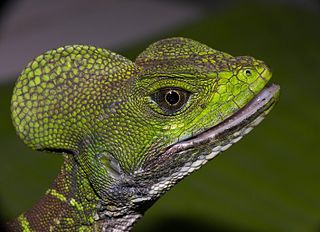
The western basilisk, or red-headed basilisk, is a large species of lizard in the family Corytophanidae. The species is endemic to northwestern South America.
Geiseltaliellus is an extinct genus of iguanian lizards that lived in what is now western Europe during the Eocene. It belongs to the family Corytophanidae, which includes modern casquehead lizards. Many fossils are known from Germany, France, and Belgium, with the most well preserved coming from the Messel pit lagerstätte in Messel, Germany. German paleontologist Oskar Kuhn named the genus in 1944 after the Geiseltal valley where the first specimens were found, designating the type species Geiseltaliellus longicaudus. Three new species — G. louisi, G. lamandini, and G. grisolli — were named in the 1990s and 2000s on the basis of more fragmentary remains from France and Belgium, although G. louisi has since been synonymized with G. longicaudus. In 2009 the Messel pit specimens were recognized as belonging to a species distinct from that of the G. longicaudus specimens in Geiseltalt and were collectively reclassified under a new name, G. maarius.























